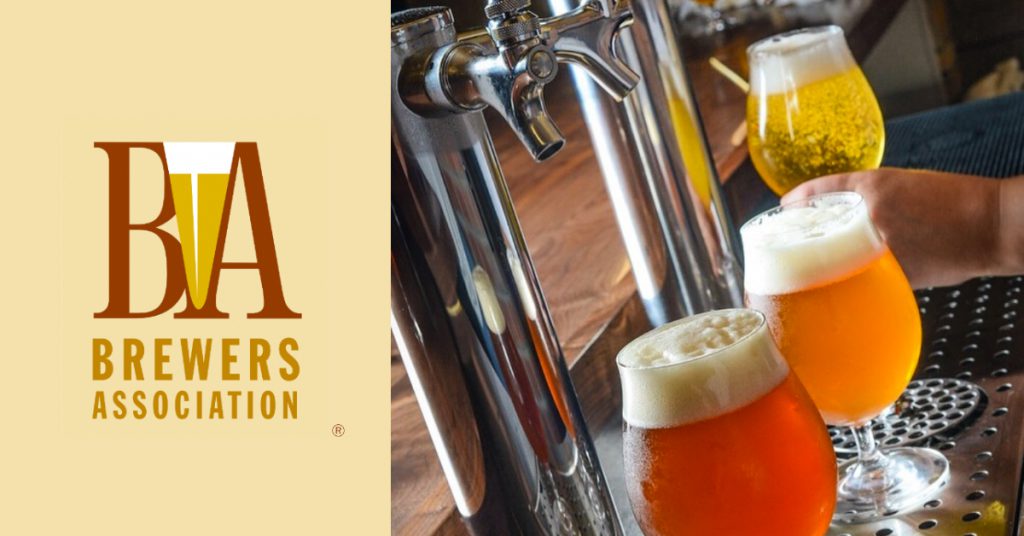
Small and independent craft brewery production totaled around 23.4 million barrels in 2023, a -1% decline compared to 2022, the Brewers Association (BA) reported today.
In a webinar following the report release, BA chief economist and VP of strategy Bart Watson noted that aside from the first year of COVID-19, this is the first “measurable drop in production” since the trade association began tracking craft volume numbers. He added that the -1% decline compared to the -2% midyear measurement “checks out very closely with scan” data, following a “positive back half of the year.”
The 2022 production numbers were revised downward to between zero and -1%, which Watson said amounted to “a couple 100,000 barrels,” which he said is “not huge changes in the grand scheme of things.”
Craft’s overall market share of the beer category increased to 13.3%, up from 13.1% in 2022. Watson explained that craft’s declines were “less negative than overall beer,” which declined -5.1% by volume last year.
The retail dollar value of the beer category, excluding cider, flavored malt beverages and hard seltzers, was estimated at $28.6 billion, representing 24.5% market share, +3% growth compared to 2022. Dollar sales due to price increases and stronger onsite sales growth compared to distribution drove the growth, while volume lagged.
Watson clarified that the BA data set includes breweries that scan data trackers Circana and NIQ may not include in their definitions of craft, such as those whose offerings are priced below typical craft offerings, such as Stevens Point and Yuengling, which Watson called “the biggest mover who had a very positive year.”
The BA’s craft data set also includes non-alcoholic craft beer makers such as Athletic Brewing, which is coming off a “strong year,” he added. Craft brewers hold “a much higher share in non-alcoholic scan they do in overall scans,” which Watson said has helped the numbers “stay less negative than it would have been otherwise.”
The number of operating craft breweries reached “an all-time high” of 9,683, an increase of 86 over the 9,597 in operation in 2022, according to the BA. The breakdown by brewery type included:
- 2,071 microbreweries (-40, 2,111 in 2022);
- 3,467 brewpubs (-9, 3,476 in 2022);
- 3,900 taproom breweries (+139, 3,761 in 2022);
- And 245 regional craft breweries (-5, from 249 in 2022).
The total U.S. operating brewery count for 2023 stood at 9,812, an increase of 82 compared to the 2022 number of 9,730 reported at this time last year.
There were 129 non-craft/large breweries in operation in 2023, down four breweries from the 133 in operation in 2022.
Asked about the production-to-capacity ratio, Watson tabbed it at between 51% and 52% in 2023, a decline from 54% in 2022. He noted that the figure can fluctuate with inclusions and exclusions from the data set.
Brewery Openings Still Outpace Closings, Employee Count +1%
The 495 brewery openings outpaced the 418 closures in 2023. However, the number of openings declined for the second consecutive year, which the BA called a reflection of “a more mature market.” The closing rate increased to around 4%, which the BA called “relatively low.”
The number of workers directly employed by craft breweries increased +1.1% compared to 2022, to 191,421.
Watson called 2023 “another competitive and challenging year for small and independent brewers.”
“[E]ven as growth has downshifted, small brewers have proved quite resilient, as seen in the increase in number of breweries, relatively low closing rates, and gains in onsite sales and jobs,” Watson said in a press release.
Draft Still a Concern
Watson said negative draft trends remain an issue for craft brewers, who represent roughly 30% of the distributed draft market. He added that draft has historically had lower barriers to entry for smaller brewers, especially in states with self-distribution.
Watson said he believes draft could be a factor in helping brands grow, but draft remains “under pressure.”
In regards to taproom and brewpub trends, Watson shared that while onsite sales in the BA’s survey were up, both brewery types’ output collectively declined due to distribution declines.
“I think we’ve seen a real slowdown in onsite sales,” he said.
The once “rock solid” business, which held steady even during the pandemic, is “starting to see the limits of what that market can look like, at least for now,” Watson added.
“Obviously things can change as you get new breweries opening, focusing in different places, different demographics, doing different stuff, different hospitality models,” he said. “And some of this may just be part of that cycle. That’s the hospitality side of the business, and anyone who knows hospitality, knows you have to reinvent yourself. The standard rule of thumb is every seven years, so we may be starting to see this.
“Brewery taprooms and brewpubs still [have] generally strong health. We didn’t see an explosion in closings. But I don’t think it’s the growth market.”
Brewery taprooms and brewpubs were both negative in the BA’s aggregated production data this year, which Watson called “one big shift.”
Expect more from Watson next week during his state of the industry speech at the Craft Brewers Conference in Las Vegas.
And look for coverage of the top 50 brewers list later today.